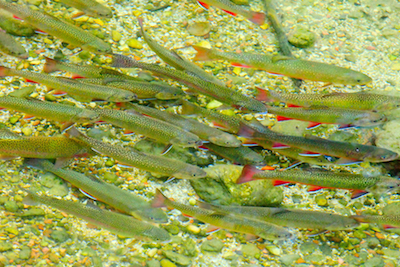Arctic Charr Habitat

Arctic char fish are both anadromous and non anadromous. Anadromous means the ability to migrate upstream to spawn.
While in the ocean the Arctic Charr holds near in inshore waters, rarely going far from the streams and rivers where they were born. However when found in rivers, they’re often found in pools and runs.
Where to find Arctic Char?
In summer, nonanadromous Arctic Charr move deep into the lakes they are living in and may go as deep as 264 to 330 feet/80 to 100 meters where the water is cold.
However anadromous Arctic Charr don’t have this need to seek out colder water and are found close to the surface during the summer months in the region’s many lakes.
As a result of the deep dwelling nonanadromous Arctic Char, it’s rare to catch one in the summer leading to larger Charr being caught in summer in the lakes.
Where do they eat?
When food is plentiful Arctic Charr remain near the mouth of the river from which they emerged and close to the surface where the prey fish are located.
In times of scarcity however, they move into offshore waters, sometimes traveling between 19 to 600 miles/30 to 1000 km from their river of origin.
However they never move too far away from the mouth of the river in search of food.
Winter Hibernation
While they don’t hibernate in the same way as bears hibernate for the winter, Arctic charr do enter a semi-state of hibernation not eating during these winter months. Like polar bears their metabolic rate slows with the onset of winter, leaving them in a semi-hibernatic state.
To survive they live on their fat reserves that are accumulated during the spring and summer months from feeding off insects, mollusks and small fish. Their diet rarely changes from these foods.
Habitat Charr Avoid
The Arctic Charr avoid construction areas or anywhere there is tailings effluent. Diversion of water flow will also scare off the Arctic Charr as will sedimentation from reservoirs and construction.


